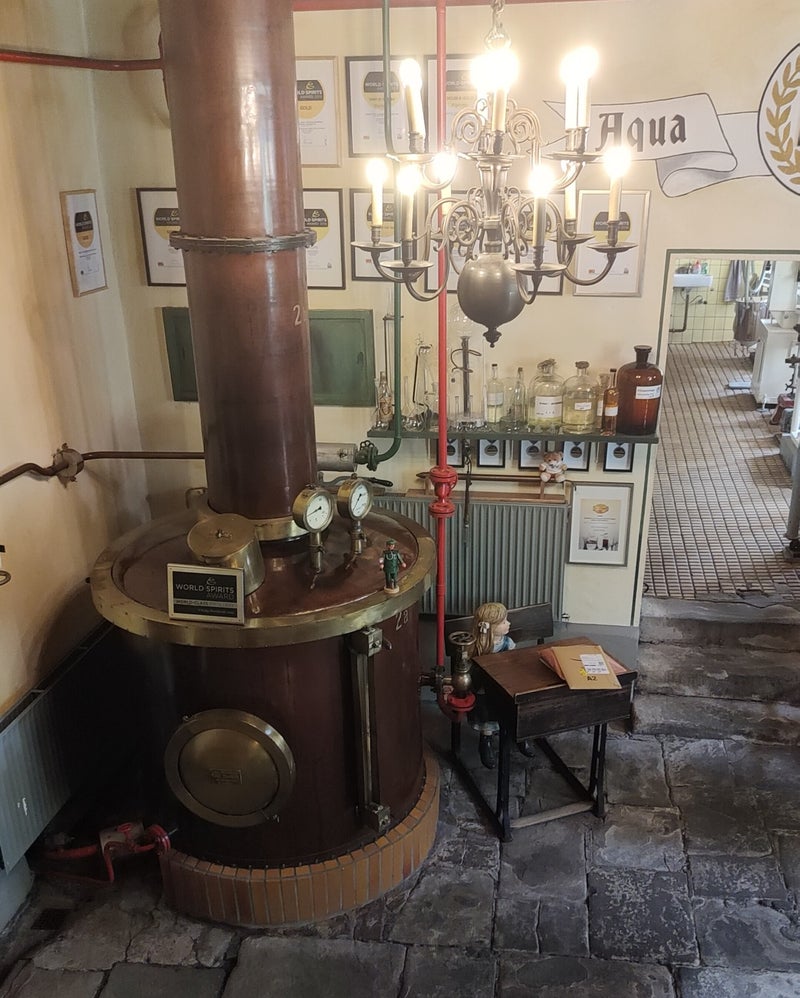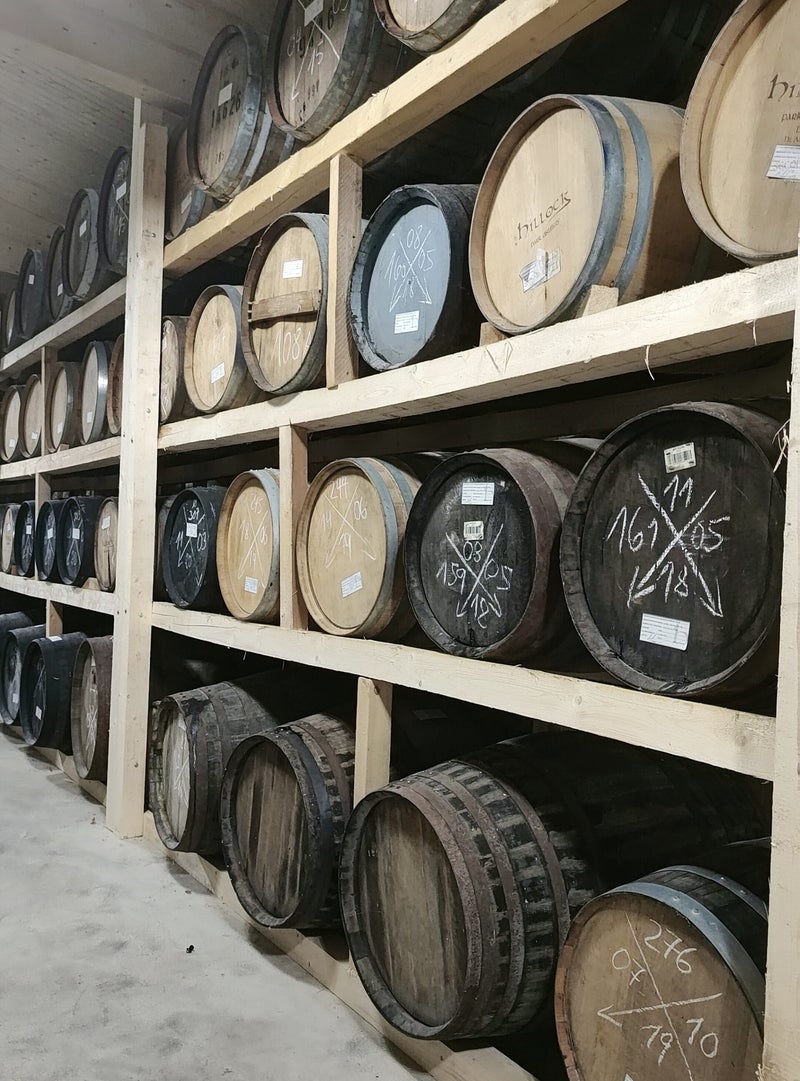“Let’s get this party started” says Jens as he welcomes me to Brennerei Habbel. I was a few minutes late thanks to train delays, coming over the border from the Netherlands and into the Ruhr. Graciously, Jens pretends not to notice how I spent a few minutes stumbling around the outside of the distillery muttering about how lost I was.

History
Jens launches right into the history of Habbel, which is a 4th generation family owned distillery: ‘we will always be family owned’, he says. Habbel sits in the hills where coal mines once fuelled the German steel industry. In fact, one hundred years ago the Ruhr produced as much coal and steel as the rest of continental Europe combined!
You’d never guess that looking at Brennerei Habbel’s surroundings, now leafy and more charming than you’d expect from nearby cities like Dortmund or Essen. Behind the main building, you look out over an enormous park area north of the distillery. Habbel now grows their own fruit amid the green hills of the Ruhrgebied.
Habbel began producing korn schnapps back in 1878, alongside herbal liqueurs like their long-lived Urwurz (orris root). They take pride in balancing herbal aromas and sugar, and liqueurs are a growing industry in Germany - so watch this space.
Coal miners in the area used to get a weekly bonus paid in beer or korn schnapps. Mines deputised distilleries to produce this for them, and Habbel was the deputat for 12 local coal mines. Just now, Habbel has released a spirit in this traditional style - 32% ABV Deputat which combines pot and column distilled wheat mash.

Habbel has a large column still rising through the core of the building, and the modern distillery has been rebuilt around it. Their old harvest cellar is now the distillery’s shop; their old gasthaus is now an impressively sleek restaurant.
I was lucky enough to meet Michel Habbel, the 4th generation owner, and his wonderful dog Alfred. Taking over the business in the 1970s, Michel began the slow shift toward whisky and also elevated the restaurant to where it is now.


The bigger picture
So Habbel is a longstanding distillery, used to distilling grains. In fact, Jens claims the oldest whisky in Germany was produced using Habbel’s old column still back in 1977. I asked about the inspirations and ambitions behind this move to whiskymaking, and Jens pointed to Japanese whisky and its transformation over the past 20 years or so. A locally popular and thriving whisky industry can become globally celebrated for its quality. Imagine if Germany could replicate this.
For my money, I think this would be great to see, but there are certainly some differences between the two countries’ whisky industries. Most notably, Germany’s distilleries are very heterogeneous, consciously pulling away from a more defined national character. We’ll definitely talk about this more in later blogs and articles, but for now, back to Habbel!

Where does Brennerei Habbel sit within the world of German whisky? Jens nods to a roughly north/south split within German distilling. The south sees more fruit schnapps making, while more cereal grains are/were distilled in the north.
Jens believes this leads to southern distilleries producing a fruitier style of spirit, citing Slyrs’ green apple aromas as an example. While we’re on the subject, Habbel apparently has a friendly connection to Slyrs. Two of the best known German whiskymakers, they are both part of the German whiskymakers’ association, the VDW.
Production & Style
On the next part of my tour, I see the new and upgraded stillhouse at Habbel. Here, their distiller Pascal talks me through their process.

The details
- 5 days fermentation with their own variety of baking yeast
- Steel washbacks
- Unfiltered mash, 3200L water added to 800kg grist
- 3 sparges of 72, 64, and 55C
- Double distillation via 1500L Holstein stills, with a column used for the 1st distillation
These pot stills are big upgrades from Habbel’s old 300L models, and they form a key part of the distillery’s conscious development of a new style - a ‘family style’. The use of rectifying columns is being reduced from what it once was while overall production grows.
To me, unfiltered mash seems to be something I see a lot more in the Netherlands and northern Germany, so it tracks with some of what Jens mentioned about a north/south divide in German whiskymaking. This practice should produce a musty edge in this otherwise clean style of whisky, but we’ll see what happens with the tasting later…
The style at Habbel is intended to be clean, making the whisky easier to enjoy at a younger age. There isn’t some instinctive need or drive to produce a 10 or 12 year old expression as there might be in Scotland. As Germany begins to build up its own whisky industry, Jens claims the focus is on Habbel’s own founders and styles more than Scotland.
Speaking of comparisons to Scotland, Habbel produces single malts but they also distil batches of rye, wheat, maize, and spelt. For their single malt, Habbel uses a mix of German barley varieties. As Jens stresses to me, this is more expensive than just getting any old grain. A tonne of German barley can cost €850, when some sources out there are as cheap as €200 or less.
To house the barrels for all this new production, Habbel built a new warehouse which opened in May 2022, and it's very impressive! Humidity-controlled, it houses sherry butts, quarter casks, ex-bourbon, new American oak, wine, port, rum.

There are even some 35 year old, 1000L vats in the corner, though these aren’t used for whisky - they can’t be, as they far exceed the maximum size for wooden casks used to make whisky in Europe. You could store finished whisky in one if you wanted, but you couldn’t age whisky in one.
Tasting
What a wonderful environment for a tasting! I could almost be in someone's back garden, shaded by walnut trees and looking out over the forest. This scenic location is all part of the broader picture for this whiskey, Jens says - “Here, we have the character of staying on the landscape.”

This is where Habbel’s whisky’s name, ‘Hillock’, comes from. ‘Habbel’ means a small hill in the local dialect, so ‘Hillock’ serves as an English translation to convey that to new drinkers.
From the first dram onward, I noticed musty aromas and sweetness which prompted Jens to talk more about the bees on site. Habbel has its own apiary, and Jens believes honey may in fact be a signature taste for the distillery’s style: ‘Bees are helping us to find our fingerprint’.
Remember what I said about the unfiltered mash, grain going into the still and making things mustier? I think this all comes together when you try Habbel. Despite being a generally light style, you can definitely tease these distinctive facets from it.
Another distinctive thing about Habbel - perhaps the first impression for most drinkers - is their unique age statements such as 4 ½ or 5 ¾. Whisky drinkers are used to only seeing a whisky’s age expressed in whole numbers of years, e.g., a 12 year old whisky. The number must reflect the minimum age of the bottle’s contents.
However, European whisky rules don’t explicitly say that age statements must be whole numbers of years, so Habbel are well within their rights to produce these expressions. The more you know!


- The 3
Habbel’s youngest whisky is tidy and straightforward, bottled at 40% ABV and presenting a light malt aroma. Grainy, but not musty, with a sweet mouthfeel. This is not a core product that Hillock is focused on - you won’t even see it on their website. Jens likes using it to show how much the whisky develops in its first three years, and this bottling helps fund a local nature reserve.

- Hillock 6
This is Habbel’s most important whisky, aged in bourbon with an oloroso finish and bottled at 46% ABV. That signature must is still there on the nose of this dram, but over three more years, it has developed into something more spiced than straight honey. The nose is toasty, with edges of glühwein. The sherry comes through on the palate and builds to a dry and warming finish.

- Sauternes 6
While this has a very similar nose to the regular 6YO, this dram adds some apricot notes to that signature musty sweetness. The mouthfeel is still quite light and sweet, and now the finish builds to classic sauternes aromas in place of sherry. This really forms a good parallel to the standard 6YO, and is available as a single cask expression.
- Chief 4
Now this is a rye whisky, made from a mash bill of 100% German rye. Take a deep breath, and the sweeter notes of rye rise out of this dram. The longer I nosed this, the stronger those notes became.
- Peated 5 ¾
Belgian malt smoked to 35ppm is used to make this expression, which spends five years in American oak and 9 months more in ex-Islay casks. Very light sweet elements come out of it, alongside very medicinal and iodine aromas without being maritime like an Islay malt.
- Peated 4 ½
This younger peated dram (46.3%) takes the same spirit as the dram above but finishes it in PX to add richer honey and clove aromas.

- The 12
Now this is special - over €200 per bottle (at 44% ABV), aged in former coal mines and finished in Italian wine casks. Is 12 years necessary to get a good whisky out of Habbel? No - the expressions above show that. However, it is interesting to see what happens when you give that honey signature time to more fully age out. The must has matured into sweet herbal and floral notes, like a sweeter Glencadam. An excellent dram!
- Liqueurs
Remember the liqueurs I mentioned before? Their honey liqueur uses early spring honey from Habbel’s own bees and is bottled at a very respectable 35% ABV using 3 year old whisky. No mistaking what flavour this is! It's part of the range to help people who don’t like whisky join in group tastings, and it can certainly do that. Even better, Habbel makes Honey and Herbs, which is even more whisky-like at 40% ABV. It smells like lavender, rosemary, and chamomile without being sickly.
Finally, Habbel’s cream liqueur (17%) is really good. I still think Five Farms is the best cream liqueur I’ve ever tried, but this is still really good. This also comes in a winter edition, 18% with a potent hazelnut-nougat aroma added.

Overall, the 6 (both the oloroso- and sauternes-finished versions) were my favourites from the lineup. That said, the new production isn’t in bottles yet, and Habbel are also moving to a new set of 700ml bottles. I’m looking forward to coming back and seeing the new range - which will apparently include a triple cask expression!
One final thing before you go - Habbel has a *whisky saloon*. I’ve never seen anything like it - a wonderful timber-built venue seating 30 to 40 people. Habbel hosts tastings here twice a week in the summer, twice a month in the winter. Plan a visit around one if you can!


Add comment
Comments